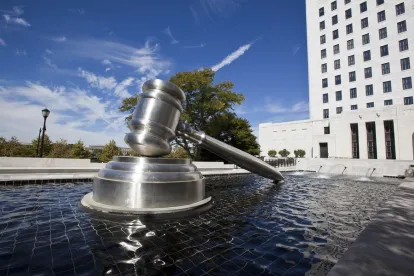Last year in West v. Bode,1 the Ohio Supreme Court determined that mineral estates are subject to the statutory double barrel of both the Marketable Title Act (MTA)2 and the Dormant Mineral Act (DMA),3 providing surface owners two simultaneous procedures for terminating long-held mineral estates and reunifying the property. In doing so, the court shot down mineral owners’ arguments that the MTA was superseded by the later-enacted DMA. In light of West, Ohio courts continue to analyze the specific operations of the MTA, with mixed results for mineral owners.4
The MTA poses a particular problem for mineral owners and lessees because it operates “automatically,” without the notice requirements and opportunity to cure afforded by the DMA.5 Instead, the MTA simply “extinguishes property interests after 40 years without a saving event, measured from the effective date of the surface owner’s root of title.”6 However, mineral owners can preserve their preexisting interest if: “(1) the preexisting interest is specifically identified in the muniments that form the record chain of title, (2) the holder of the preexisting interest has recorded a notice claiming the interest, . . . or (3) the preexisting interest arises out of a title transaction that was recorded subsequent to the effective date of the root of title.”7
The “Specifically Identified” Interest Exception – Erickson v. Morrison
On 13 January 2021, in Erickson v. Morrison,8 the Ohio Supreme Court analyzed the MTA’s first exception and held that language may be sufficiently specific even if it does not name the interest holder. Erickson involved property that was severed in 1926, with a mineral reservation stating “[e]xcepting and reserving therefrom all coal, gas, and oil with the right of said first parties, their heirs and assigns, at any time to drill and operate for oil and gas and to mine all coal.”9 The surface rights were then transferred several times, and each transfer was properly recorded and included similar “excepting and reserving” language.10 The operative deed was recorded in 1978 and stated: “EXCEPTING AND RESERVING THEREFROM all coal, gas and oil with the right of first parties, their heirs and assigns, at any time to drill and operate for oil and gas and mine all coal.”11
In 2017, the successors in interest to the mineral estate filed an action to quiet title and for a declaration that they retained ownership of the mineral estate through the reservation.12 The surface owners counterclaimed for a declaration that the mineral reservation was extinguished under the MTA.13 The mineral owners prevailed at the trial court, but the Fifth District Court of Appeals of Ohio reversed, and the mineral owners appealed to the Ohio Supreme Court.14
On appeal, the mineral owners argued that their interest was preserved by the MTA’s first exception, R.C. 5301.49(A), which preserves preexisting interests specifically identified in the muniments of the surface owner’s record chain of title.15 The surface owners argued that the reservation language in their deed was not sufficiently specific because it did not specifically name the mineral owners.16
The court focused on the language of the exception, which preserves “[a]ll interests and defects which are inherent in the muniments of which such chain of record title is formed; provided that a general reference . . . shall not be sufficient to preserve them, unless specific identification be made therein . . . .”17 The court noted that the exception does not define the terms “general” or “specific,”18 and the statute “does not expressly require a reference to a prior interest to include the name of the interest’s owner.”19 Instead, the court suggested that the distinction is likely directed at the “common conveyancing practice for draftsmen to include . . . some such language as ‘subject to easements and use restrictions of record,’” which is designed to “protect the grantor from liability” but “leaves it unclear whether a prior interest in fact exists.”20 Thus, the court concluded that “a recitation . . . is not a general reference . . . simply because it does not name the owner.”21 Accordingly, the court held that the “excepting and reserving” language in the surface owners’ deed was sufficiently specific to preserve the mineral interest, even though it did not name the mineral owners.22
The Subsequently Recorded Title Transaction Exception – Lucas v. Whyte
Even after Erickson, on 22 January 2021, in Lucas v. Whyte,23 the Seventh District Court of Appeals of Ohio analyzed the MTA’s third exception and held that oil and gas leases qualify as title transactions that trigger the exception, so long as they are properly recorded. Lucas involved property located in Monroe County, Ohio, originally owned by John Miller.24 In 1914, Miller sold the surface estate but reserved a one-half interest in the mineral estate.25 In 1940, Miller died intestate, and his estate was handled by the probate court of Belmont County, Ohio.26 The Belmont County court then sent the Monroe County recorder a certificate of Miller’s real estate, including the reserved mineral interest.27
In 1966, Lucas acquired the surface estate by quitclaim deed.28 Subsequently, three of Miller’s heirs died and their estates were also handled by the Belmont County court, but the records were not recorded in Monroe County.29 In 2017, two of Miller’s remaining heirs executed oil and gas leases, which were recorded in Monroe County.30
In 2018, Lucas filed a complaint to quiet title, alleging that the Miller reservation was extinguished under the MTA.31 The Miller heirs responded that, pursuant to the R.C. 5301.49(D) exception to the MTA, the probate and lease records precluded extinguishment.32 The trial court granted summary judgment in favor of Lucas.33
On appeal, the Seventh District Court of Appeals of Ohio analyzed the exception, which preserves:
Any interest arising out of a title transaction which has been recorded subsequent to the effective date of the root of title from which the unbroken chain of title or record is started; provided that such recording shall not revive or give validity to any interest which has been extinguished prior to the time of the recording . . .34
The court interpreted this language to require three essential elements to preserve an interest: (i) a title transaction;35 (ii) proper recordation;36 and (iii) timely recordation.37 Under the first element, the court held that both probate records and oil and gas leases can be considered title transactions.38 However, under the second element, the court held “a title transaction must be recorded in the county where the real property is located in order for the R.C. 5301.49(D) exception to apply.”39 Therefore, the probate records, which were filed in Belmont County, not Monroe County, were not properly recorded and could not preserve the Miller heirs’ interest.40 Alternatively, the 2017 oil and gas leases were properly recorded in Monroe County, but they were not timely recorded within 40 years of Lucas’s 1966 deed.41 Accordingly, the court held that none of the records met the elements of R.C. 5301.49(D) and the general provisions of the MTA operated to extinguish the Miller heirs’ mineral estate.42
Conclusion
Ultimately, the key takeaways from Erickson and Lucas soften the blow of West and the automatic extinguishment provisions of the MTA. Erickson expressly protects mineral interests even when the interest holder is not named in subsequent reservations. More broadly, the court’s ruling suggests that Ohio courts should take a more liberal approach when applying MTA exceptions. Likewise, oil and gas companies may find Lucas particularly helpful in its determination that a timely recorded lease preserves the mineral interest.
[1] West v. Bode, slip op. 2020-Ohio-5473, reconsideration denied, slip op. 2020-Ohio-6835. Although both statutes yield the same result, the court determined the statutes were not in conflict, explaining:
[T]he Marketable Title Act and the Dormant Mineral Act operate differently and after different periods of time. The Marketable Title Act extinguishes property interests after 40 years without a saving event, measured from the effective date of the surface owner’s root of title; the Dormant Mineral Act provides a mechanism that a surface owner may use to have a severed mineral interest deemed abandoned and vested in the surface owner after a shorter, 20-year period.
Id. at ¶ 28.
[2] Marketable Title Act, Ohio Rev. Code §§ 5301.47 et seq. (1961).
[3] Dormant Mineral Act, Ohio Rev. Code § 5301.56 (1988).
[4] See, e.g., Erickson v. Morrison, slip op. 2021-Ohio-746 (addressing the MTA’s first exception and holding that “[l]anguage can refer to a specific interest in the chain of title without including a name, just as it can be sufficiently specific without ‘the volume and page number where the interest was created or the date that the interest was recorded’”); Lucas v. Whyte, slip op. 2021-Ohio-222 (addressing the MTA’s third exception and holding that records which trigger the exception “must be recorded in the county where the real property is located”).
[5] West, 2020-Ohio-5473, at ¶ 27. “The General Assembly amended the Dormant Mineral Act in 2006, in part to require a surface owner to initiate a notice procedure . . . before a mineral interest could be deemed abandoned and vested in the surface owner . . . [and] afforded a mineral-interest holder the opportunity to preserve that interest, even after the passage of 20 years without a saving event, by filing a notice of preservation within 60 days after the surface owner serves notice of intent to declare the mineral interest abandoned.” Id. at ¶ 24.
[6] Id. at ¶ 28.
[7] Id. at ¶¶ 15–16 (citing Ohio Rev. Code § 5301.49(A), (B), and (D)).
[8] Erickson, 2021-Ohio-746.
[9] Id. at ¶ 5.
[10] Id. at ¶ 6.
[11] Id. at ¶ 7.
[12] Id. at ¶ 8.
[13] Id.
[14] Id. at ¶¶ 9–10.
[15] Id. at ¶ 12. The mineral owners also argued that a surface owner’s actual knowledge of a mineral interest would preserve the mineral interest, but the court declined to address this argument, finding “resolution on the first proposition of law resolves this case.” Id. at ¶ 11.
[16] Id. at ¶ 13.
[17] Id. at ¶ 17 (quoting Ohio Rev. Code § 5301.49(A)).
[18] Id. at ¶¶ 20–21. The court also noted that in 1988, the legislature amended the MTA to require greater specificity under R.C. 5301.51(A) and 5301.52(A), but the legislature declined to include such specificity requirements under R.C. 5301.49(A). Id. at ¶¶ 27–28.
[19] Id. at ¶ 27.
[20] Id. at ¶ 30 (quoting Allan F. Smith, The New Marketable Title Act, 22 Ohio St. L.J. 712, 717 (1961)).
[21] Id. at ¶ 31. The court also reiterated its prior holding that a referenced interest “can be sufficiently specific without ‘the volume and page number where the interest was created or the date that the interest was recorded.’” Id. at ¶ 25 (quoting Blackstone v. Moore, 122 N.E.3d 132, 136 (Ohio 2018)).
[22] Id. at ¶ 32.
[23] Lucas, 2021-Ohio-222.
[24] Id. at ¶ 2.
[25] Id.
[26] Id. at ¶ 3.
[27] Id.
[28] Id. at ¶ 5.
[29] Id. at ¶¶ 29–34.
[30] Id. at ¶ 39.
[31] Id. at ¶ 7.
[32] Id. at ¶ 11.
[33] Id. at ¶ 15.
[34] Id. at ¶ 27 (quoting Ohio Rev. Code § 5301.49(D)).
[35] Id. at ¶ 29.
[36] Id. at ¶ 38.
[37] Id. at ¶ 40.
[38] Id. at ¶¶ 29, 39.
[39] Id. at ¶ 38.
[40] Id.
[41] Id. at ¶ 40.
[42] Id. at ¶ 41.




 />i
/>i

